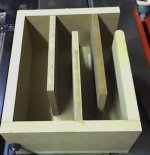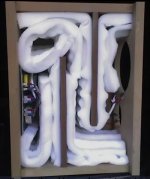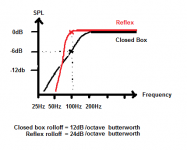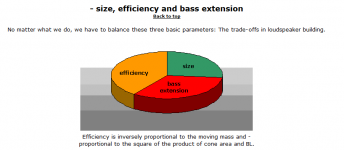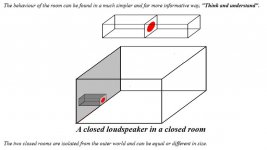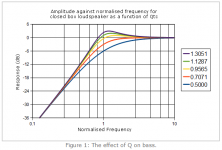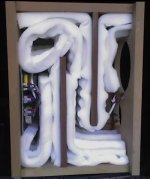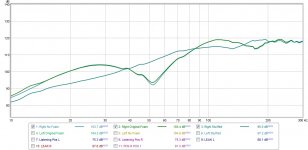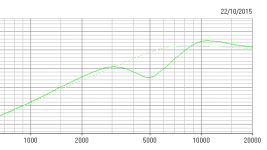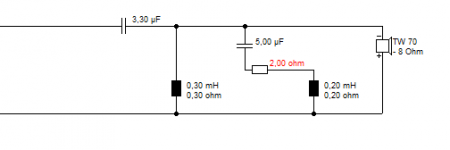Just so there's no misunderstanding, I'm not simply dismissing the seminal TL work performed by Bailey and Bradbury, but that doesn't automatically mean that all of their theories and conclusions were correct. Those studies, however, occurred a really long time ago in technology-years. We now have newer and much better tools, techniques, materials, etc. to use. Many theories that were thought to be correct in many areas have been disproved (like "the earth is flat") and it's absolutely ridiculous to cling to something simply because it was once accepted as correct while ignoring new information that disproves it. Regarding TLs some facts are simply indisputable: A column of air closed on one end and open on the other end will have its 1/4-wavelength frequency as the primary resonance. All TLs are 4th-order systems and will inherently have twin impedance peaks. The lower-frequency impedance peak can be completely eliminated with stuffing, but that also completely eliminates any terminus output and bass reinforcement, converting the performance of the TL essentially into that of a sealed but overly complex box. Several materials work quite well for stuffing TLs and will have virtually identical effects with different but appropriate densities.
Paul
Paul
...converting the performance of the TL essentially into that of a sealed but overly complex box…
It should be noted that if you are using a driver that is normally too high to use in a box, the above can be used to get the box Q as low as possible.
dave
Just so there's no misunderstanding, I'm not simply dismissing the seminal TL work performed by Bailey and Bradbury, but that doesn't automatically mean that all of their theories and conclusions were correct. Those studies, however, occurred a really long time ago in technology-years. We now have newer and much better tools, techniques, materials, etc. to use. Many theories that were thought to be correct in many areas have been disproved (like "the earth is flat") and it's absolutely ridiculous to cling to something simply because it was once accepted as correct while ignoring new information that disproves it. Regarding TLs some facts are simply indisputable: A column of air closed on one end and open on the other end will have its 1/4-wavelength frequency as the primary resonance. All TLs are 4th-order systems and will inherently have twin impedance peaks. The lower-frequency impedance peak can be completely eliminated with stuffing, but that also completely eliminates any terminus output and bass reinforcement, converting the performance of the TL essentially into that of a sealed but overly complex box. Several materials work quite well for stuffing TLs and will have virtually identical effects with different but appropriate densities.
Paul
Paul,
You will change your comments once you build a Bailey transmission line, stuff it with long fiber wool, and make impedance and SPL measurements. The Newtonian mechanics and calculus that Bailey and Bradbury used had not change for 400 years and are still being used for the most advanced technologically projects that are earth bounded.
You are talking about an transparent air column. Bradbury investigated the fluid dynamics of how acoustic wave propagate in an long fiber wool filled air column. Both are physically true, but different subject. Anyone who says that the Bradbury theory is wrong need to point out the specific mistake in his analysis or test technique. (I cannot find any.)
I do not have the equipment to conduct the complex Bailey and Bradbury tests. But I built the Bailey line and did the standard speaker (impedance and SPL) measurement. The stuffing is 1/2 lb/cuft of long fiber wool with the terminus open. The impedance curve has a single peak near the woofer resonant frequency, Fs. These measurements and my listening test convinced me that Bailey and Bradbury are correct. (I have not seen a Bailey line with double peaks unless, of course, you pull out the long fiber wool stuffing.)
The PMC people seem to do a good job duplicating the Bailey TL characteristics in their products. I hate to see BlindMelon7 get misled into converting his speaker into a bass reflex box.
Last edited:
ANY line, whether you call it a Bailey line or an MJK line or a pkitt line, will have twin impedance peaks with no stuffing, just as you say, and all of them can be made to have only one impedance peak when stuffed appropriately with any one of several materials. There's absolutely nothing magical about long-fiber wool; it and polyester fiber and fiberglass all act as acoustical low-pass filters, varying in only how dense each has to be in order to cause the very same effects. AFAIC, you are missing the most important point. Your "Bailey" line with its single impedance peak is doing nothing to support the bass response of the woofer. It's simply acting like a large, sealed box which, as Planet 10 posted, may be very useful for a high-Qts driver.
MY impedance and listening tests for all of my TL builds (with those dreaded twin impedance peaks) convinced me that George Augsperger and Martin King are correct, and I hope BlindMelon7 wants to build a TL that helps its woofer perform at its best.
MY impedance and listening tests for all of my TL builds (with those dreaded twin impedance peaks) convinced me that George Augsperger and Martin King are correct, and I hope BlindMelon7 wants to build a TL that helps its woofer perform at its best.
Paul,
You will change your comments once you build a Bailey transmission line, stuff it with long fiber wool, and make impedance and SPL measurements. The Newtonian mechanics and calculus that Bailey and Bradbury used had not change for 400 years and are still being used for the most advanced technologically projects that are earth bounded.
You are talking about an transparent air column. Bradbury investigated the fluid dynamics of how acoustic wave propagate in an long fiber wool filled air column. Both are physically true, but different subject. Anyone who says that the Bradbury theory is wrong need to point out the specific mistake in his analysis or test technique. (I cannot find any.)
I do not have the equipment to conduct the complex Bailey and Bradbury tests. But I built the Bailey line and did the standard speaker (impedance and SPL) measurement. The stuffing is 1/2 lb/cuft of long fiber wool with the terminus open. The impedance curve has a single peak near the woofer resonant frequency, Fs. These measurements and my listening test convinced me that Bailey and Bradbury are correct. (I have not seen a Bailey line with double peaks unless, of course, you pull out the long fiber wool stuffing.)
The PMC people seem to do a good job duplicating the Bailey TL characteristics in their products. I hate to see BlindMelon7 get misled into converting his speaker into a bass reflex box.
Last edited:
You will change your comments once you build a Bailey transmission line, stuff it with long fiber wool, and make impedance and SPL measurements.
Been there, done that, Bailey's line models just fine in MJK
The PMC people seem to do a good job duplicating the Bailey TL characteristics in their products. I hate to see BlindMelon7 get misled into converting his speaker into a bass reflex box.
Bit according to you it already is, based on the impedance.
An externally hosted image should be here but it was not working when we last tested it.
dave
Your "Bailey" line with its single impedance peak is doing nothing to support the bass response of the woofer.
The bailey line is not stuffed quite that much, he is taking advantage of the 1/4 wave resonance to extend the bass somewhat.
keilau is one of those who does not understand the title of the article, and what the article that follows actually says. The Bailey TL is a 1/4 wave resonant enclosure, but stuffed enuff to not a helmholz resonant cabinet.
dave
PS: the 1st published work on TLs was in 1937 by Onley
Thanks, Dave. I made no attempt to look up any details on the Bailey line to refresh my memory. I just assumed, since keilau makes such big issue about a single impedance peak as a must have characteristic, that's what the Bailey line had, resulting in no or virtually no bass extension from the terminus.
Paul
Paul
The bailey line is not stuffed quite that much, he is taking advantage of the 1/4 wave resonance to extend the bass somewhat.
keilau is one of those who does not understand the title of the article. The Bailey TL is a 1/4 wave resonant enclosure, but not a helmholz resonant cabinet.
dave
What a ridiculous and unhelpful squabble. Not helping BlindMelonChitlin7 (sic) at all...😱
Clearly it's closed box implemented with a tapered TL with a heavy sock or foam at the end. Which is also a bit like the aperiodic vent, which is foam held between two rigid grilles, but effectively a light sock or drinking straws which was another way of doing this to a reflex vent.

Near 12dB/octave with the damping on the port. Simple as. Somewhere between 1/4 wave transmission line and closed box. There's only so many filter profiles possible. Closed box at 12dB/octave. Reflex at 24dB/octave. And then a few variations in between. Odd order 18dB/octave, ripply Chebysheff, whatever.
So basically, BlindMelon7, you want a great big splodge of damping foam at the back port. Then you don't get the dip.
Clearly it's closed box implemented with a tapered TL with a heavy sock or foam at the end. Which is also a bit like the aperiodic vent, which is foam held between two rigid grilles, but effectively a light sock or drinking straws which was another way of doing this to a reflex vent.

Near 12dB/octave with the damping on the port. Simple as. Somewhere between 1/4 wave transmission line and closed box. There's only so many filter profiles possible. Closed box at 12dB/octave. Reflex at 24dB/octave. And then a few variations in between. Odd order 18dB/octave, ripply Chebysheff, whatever.
So basically, BlindMelon7, you want a great big splodge of damping foam at the back port. Then you don't get the dip.
Does anyone have dimensions of this TL, and the XO frequency and slopes? I would like to model it in Akabak. I believe it uses the P17Wj 6.5in woofer and the D25AG-35 tweeter. Are these the correct drivers?
This one has a silk dome tweeter:
There seems to be an older version with an aluminum dome tweeter:

It seems to be the PMC posterboy for the ATL as shown in many cutaway images such as this one (I could extract dimensions from this image, but easier if someone has actually measured one or has provided specs):

Although I am tempted to just make a smaller homage from scratch using an Aurum Cantus AC130F1 and a Dayton ND25FA-4.
This one has a silk dome tweeter:
An externally hosted image should be here but it was not working when we last tested it.
There seems to be an older version with an aluminum dome tweeter:

It seems to be the PMC posterboy for the ATL as shown in many cutaway images such as this one (I could extract dimensions from this image, but easier if someone has actually measured one or has provided specs):

Although I am tempted to just make a smaller homage from scratch using an Aurum Cantus AC130F1 and a Dayton ND25FA-4.
Last edited:
Well, the metal tweeter looks like the Vifa D25AG to me. It's a 5" or 6" Vifa bass, maybe the splendid old P17WJ 6", maybe polycone, maybe paper. Apparently second order slopes with the characteristic omega impedance profile.
But as far as the stuffing goes, which is what this thread is about, the guy who cloned either the TB1 or the DB1 ended up with the below. Says it all really.
https://www.gearslutz.com/board/geekslutz-forum/114230-my-pmc-inspired-monitor-build.html
It looks like about 15 or 20L. Since it's close to closed box, the length of the heavily damped port TL probably isn't too critical.
But as far as the stuffing goes, which is what this thread is about, the guy who cloned either the TB1 or the DB1 ended up with the below. Says it all really.
https://www.gearslutz.com/board/geekslutz-forum/114230-my-pmc-inspired-monitor-build.html
It looks like about 15 or 20L. Since it's close to closed box, the length of the heavily damped port TL probably isn't too critical.
Attachments
Last edited:
Does anyone have dimensions of this TL
I believe i did a drawing so that a sim could be done, but it will be at home.
A search may turn up that result on this forum.
dave
Well, the metal tweeter looks like the Vifa D25AG to me. It's a 5" or 6" Vifa bass, maybe the splendid old P17WJ 6", maybe polycone, maybe paper. Apparently second order slopes with the characteristic omega impedance profile.
But as far as the stuffing goes, which is what this thread is about, the guy who cloned either the TB1 or the DB1 ended up with the below. Says it all really.
https://www.gearslutz.com/board/geekslutz-forum/114230-my-pmc-inspired-monitor-build.html
It looks like about 15 or 20L. Since it's close to closed box, the length of the heavily damped port TL probably isn't too critical.
That diy attempt appears to have way too much stuffing compared to the original shown in the cutaway photo. I don't think there will be much bass coming out of a TL packed with that much open cell mattress foam. The driver does look like the popular P17WJ polycone.
Here are factory plans of the TB2 and TB2a from PMC, so I imagine plans of the TB1 are floating around somewhere...
http://www.diyaudio.com/forums/attachments/multi-way/232411d1311446036-pmc-clones-tb2.pdf
http://www.diyaudio.com/forums/attachments/multi-way/232410d1311446036-pmc-clones-tb2a1.pdf
Measurements of a clone built to the TB2 dims don't seem very impressive bass wise. I could have gotten 90Hz f3 with a sealed box and any number of 5.25 or 6.5in mid bass drivers.
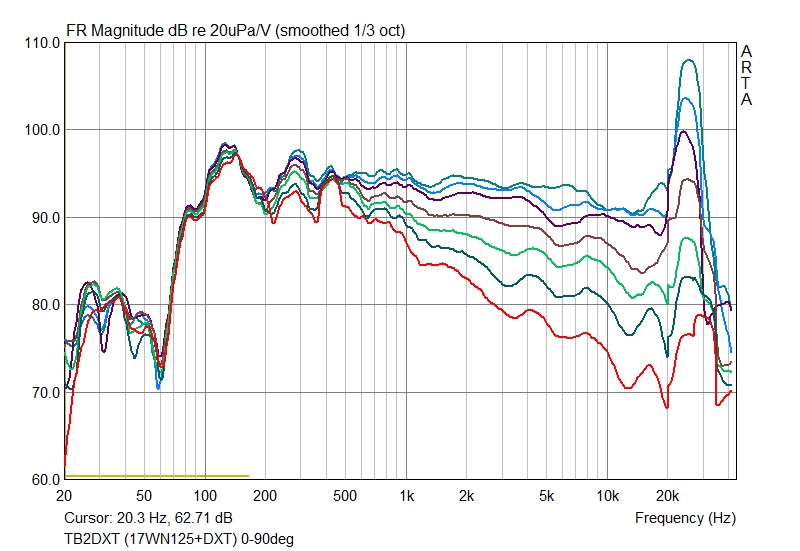
Last edited:
The link was confusing about the TB1 and the DB1.
But he said he had too much stuffing along the line initially.
But the main event is the termination. Well stuffed. Which makes sense. Near closed box.
But he said he had too much stuffing along the line initially.
But the main event is the termination. Well stuffed. Which makes sense. Near closed box.
So really the purpose of the DB1 ATL is to provide a good aperiodic absorption of the back wave rather than augmenting bass with any real terminus output? Heck, a Dagger or coiled up Dagger, the Nautaloss (derived from the B&W Nautilus) could have done that in a much smaller compact form factor.
http://www.diyaudio.com/forums/full-range/247598-nautaloss-ref-monitor.html
http://www.diyaudio.com/forums/full-range/247598-nautaloss-ref-monitor.html
I don't know why people get their knickers in a twist so much about bass performance.
If you want big bass from small boxes you sacrifice efficiency. Acoustic Suspension is the most extreme example. Which uses low Qts aka reflex type, high mass drivers in overstuffed closed box.
This untapered TL from PMC clearly runs into a Chebyshev type bass ripple if underdamped. Which is what Blind Melon7 is talking about.

For every reflex, transmission line or closed box, there are clearly in-between solutions. Choose your poison. The same goes for small baffles and infinite ones. But really there is no replacement for displacement IMO.
If you want big bass from small boxes you sacrifice efficiency. Acoustic Suspension is the most extreme example. Which uses low Qts aka reflex type, high mass drivers in overstuffed closed box.
This untapered TL from PMC clearly runs into a Chebyshev type bass ripple if underdamped. Which is what Blind Melon7 is talking about.

For every reflex, transmission line or closed box, there are clearly in-between solutions. Choose your poison. The same goes for small baffles and infinite ones. But really there is no replacement for displacement IMO.
Attachments
Wow! This is a fascinating discussion. I've always been interested in the TL design as my first proper hi-fi speakers were the LEAK 3090s (which I still have of course.) They have a 15" sandwich driver in a 105L TL 😀
I moved them into another room to have a quick listen. I didn't really fancy carting all my audio gear so I had to trust my ears. While there was definitely MORE bass with the ports stuffed, it was in no way better. Playing a bass line on it's own the notes were noticeably out of tune (sharper.) With the original foam they sounded a little bass light, but with a lovely smooth roll-off and loads of clarity. I think I just need to spend more time on my room (doh!) and maybe think about building a couple of TL subs to go with? Hell I could even use the bottom half of the LEAKs as subs!
I moved them into another room to have a quick listen. I didn't really fancy carting all my audio gear so I had to trust my ears. While there was definitely MORE bass with the ports stuffed, it was in no way better. Playing a bass line on it's own the notes were noticeably out of tune (sharper.) With the original foam they sounded a little bass light, but with a lovely smooth roll-off and loads of clarity. I think I just need to spend more time on my room (doh!) and maybe think about building a couple of TL subs to go with? Hell I could even use the bottom half of the LEAKs as subs!
It IS interesting. I always prefer the clarity of the airy midrange with reflex. But the bass performance of closed box.
Presumably there will be an optimal damping and room placement that hits the spot for you. And the room and nearby walls affects bass greatly.
Presumably this speaker has an internal volume somewhere inbetween the closed box optimum and the reflex optimum, being a bit inbetween itself! 😀
The closed box formulas are here, and the optimal closed box is less than the Vas for Qts less than 0.5:
http://www.diyaudio.com/forums/diyaudio-com-articles/158899-arpeggio-loudspeaker.html
With a Qts of 0.38, the optimal reflex volume is simply the Vas.
Presumably there will be an optimal damping and room placement that hits the spot for you. And the room and nearby walls affects bass greatly.
Presumably this speaker has an internal volume somewhere inbetween the closed box optimum and the reflex optimum, being a bit inbetween itself! 😀
The closed box formulas are here, and the optimal closed box is less than the Vas for Qts less than 0.5:
http://www.diyaudio.com/forums/diyaudio-com-articles/158899-arpeggio-loudspeaker.html
With a Qts of 0.38, the optimal reflex volume is simply the Vas.
Attachments
Last edited:
Wow! This is a fascinating discussion. I've always been interested in the TL design as my first proper hi-fi speakers were the LEAK 3090s (which I still have of course.) They have a 15" sandwich driver in a 105L TL 😀
I moved them into another room to have a quick listen. I didn't really fancy carting all my audio gear so I had to trust my ears. While there was definitely MORE bass with the ports stuffed, it was in no way better. Playing a bass line on it's own the notes were noticeably out of tune (sharper.) With the original foam they sounded a little bass light, but with a lovely smooth roll-off and loads of clarity. I think I just need to spend more time on my room (doh!) and maybe think about building a couple of TL subs to go with? Hell I could even use the bottom half of the LEAKs as subs!
You hit it right on when you said "With the original foam they sounded a little bass light, but with a lovely smooth roll-off and loads of clarity."
The objective of a Bailey TL or aperiodic is to get the non-ringing bass of an infinite baffle that is characterized by the slow 12 dB/octave bass slope and the single impedance peak. TL gets the efficiency back using a large cabinet to create a half wave phase inverter. Aperiodic keeps the box small, but sacrifice some of the efficiency. PMC seems to execute these basic principles quite well in their designs. It is good to stick with the original foam stuffing and terminus puck.
From your measurement, the PMC TB1 seems like an excellent design. Like for Steve (System7), a 24 dB/octove fast rolling off bass of a bass reflex box just does not do it for me.
My TDL T-Line 3s have a very flat impedance curve.
Impedance is much easier to measure than low frequency acoustic measurements
At first try, one speaker curve looked odd, revealing an air leak
Impedance is much easier to measure than low frequency acoustic measurements
At first try, one speaker curve looked odd, revealing an air leak
Last edited:
I was doing some modelling of a second order high pass this morning, which whether electrical or mechanical is like a 12dB/octave 2nd order butterworth closed box.
What happens if I add a resonant pipe aka reflex or LCR notch to it and play around with the red damping resistor?
Blow me down, it looks just like the PMC's behaviour! Filters are filters, whether electrical or mechanical. 😀
What happens if I add a resonant pipe aka reflex or LCR notch to it and play around with the red damping resistor?
Blow me down, it looks just like the PMC's behaviour! Filters are filters, whether electrical or mechanical. 😀
Attachments
- Status
- Not open for further replies.
- Home
- Loudspeakers
- Multi-Way
- PMC TL Stuffing
